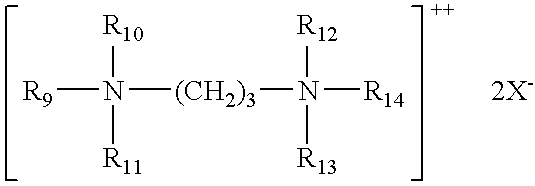Topical administration of at least one double-stranded RNA oligonucleotide (dsRNA)
a technology of rna oligonucleotide and double-stranded rna, which is applied in the field of topical administration of at least one double-stranded rna oligonucleotide (dsrna), can solve the problems of inability to achieve the quantity, application limitations, and inability to achieve desirable effects, and achieve the effect of reducing the quantity of double-stranded rna oligonucleo
- Summary
- Abstract
- Description
- Claims
- Application Information
AI Technical Summary
Benefits of technology
Problems solved by technology
Method used
Image
Examples
example 1
Using RNA Interference to Inhibit the Expression of Tyrosinase:
[0206] Materials and Methods:
[0207] The experimental conditions are those described by Tuschl et al. (Journal of Cell Science, 2001, 114, 45574565).
[0208] 24 h before transfection, the melanocytes (MeWo cells) are sown, at the rate of 40,000 cells / well, in 500 μl of DMEM medium+10% serum in a 24-well plate. 0.84 μg or 2.52 μg of duplex siRNA (see description below), that is 60 pmol of tyrosinase siRNA in 3 μl of annealing buffer (Dharmacon) or, respectively, 180 pmol of tyrosinase siRNA in 9 μl of annealing buffer, are used per well. 3 μl or 9 μl of 20 μM tyrosinase duplex siRNA are diluted in 50 μl of Opti-MEM (Gibco). In another tube, 3 μl of oligofectamine (Invitrogen) are diluted in 12 μl of Opti-MEM and incubated at room temperature for 10 minutes. The 2 solutions are mixed and incubated at room temperature for 20 minutes before being added to the cells. The cells are then incubated at 37° C. for 96 h, with a cha...
example 2
Compositions:
[0229] Composition 1: The double-stranded RNA oligonucleotide is complexed on the surface of cationic vesicles:
[0230] Preparing the vesicles:
PEG 400 isostearate8%Polyethyleneimine (PEI of 200 to 100 000 MW)2%amidified with isostearic acidDistilled waterqs for 100%
[0231] Double-stranded RNA oligonucleotides of SEQ ID No. 1 and SEQ ID No. 2, with a dsRNA / PEI ratio of between 0.1 and 1000.
[0232] Steps Involved in Preparing Vesicles: [0233] solubilizing the lipids in a methanol / chloroform mixture; [0234] evaporating the solvent in a rotary evaporator under reduced pressure in order to obtain a lipid film; [0235] hydrating the film while ultrasonicating; [0236] checking the diameter of the vesicles (less than 1 μm; preferably 200 nm); [0237] adding the solution of double-stranded RNA oligonucleotides.
[0238] Cosmetic Composition:
[0239] The vesicles are then incorporated into a cosmetic formulation which is suitable for topical application.
[0240] Daily application, pre...
PUM
| Property | Measurement | Unit |
|---|---|---|
| diameter | aaaaa | aaaaa |
| diameter | aaaaa | aaaaa |
| diameter | aaaaa | aaaaa |
Abstract
Description
Claims
Application Information
 Login to View More
Login to View More - R&D
- Intellectual Property
- Life Sciences
- Materials
- Tech Scout
- Unparalleled Data Quality
- Higher Quality Content
- 60% Fewer Hallucinations
Browse by: Latest US Patents, China's latest patents, Technical Efficacy Thesaurus, Application Domain, Technology Topic, Popular Technical Reports.
© 2025 PatSnap. All rights reserved.Legal|Privacy policy|Modern Slavery Act Transparency Statement|Sitemap|About US| Contact US: help@patsnap.com



